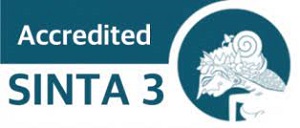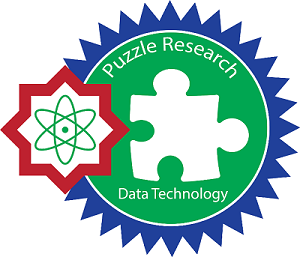ADDITIONAL MENU
Implementation of Convolutional Neural Network for Classification of Density Scale and Transparency of Needle Leaf Types
Abstract
Crown density and transparency are among the parameters in determining forest health using magic card. This is still less effective because it only relies on direct vision. Therefore, a more sophisticated and accurate application using digital image technology is needed. Convolutional Neural Network (CNN) is designed to help recognize objects in images with various positions. There are 1000 images of needle leaf types with ten classes of crown density and transparency for every kind of needle leaf, including araucaria heterophylla, cupressus retusa, pine merkusii, and shorea javanica, which are classified using AlexNet. AlexNet is a CNN architecture that has eight feature extraction layers. The AlexNet model succeeded in classifying coniferous trees on the scale of density and crown transparency with an accuracy level of 87.00% for araucaria heterophylla, cupressus retusa 96.00%, merkusii pine 86.00%, and shorea javanica 95.00%. Although some errors were still found in classification, this was caused by similar patterns and similar image positions. It is hoped that the results of this research will be used in monitoring forest health in the future.
Full Text:
PDFReferences
Melaponty, Togar Fernando Manurung, and Fahrizal, “Keanekaragaman Jenis Vegetasi Tegakan Hutan pada Kawasan Hutan Kota Bukit Senja Kecamatan Singkawangan Tengah Kota Singkawang,” 2019.
Ardiatma Maulana, Priyono Suryanto, Widiyatno, Eny Faridah, and Bambang Suwignyo, “Dinamika Suksesi Vegetasi pada Areal Pasca Perladangan Berpindah di Kalimantan Tengah,” Jurnal Ilmu Kehutanan , pp. 181–194, 2019.
R. Safe’i, F. S. Latumahina, B. S. Dewi, and F. Ardiansyah, “Short communication: Assessing the state and change of forest health of the proposed arboretum in Wan Abdul Rachman Grand Forest Park, Lampung, Indonesia,” Biodiversitas, vol. 22, no. 4, pp. 2072–2077, 2021, doi: 10.13057/biodiv/d220456.
D. Pertiwi, “Kondisi Kesehatan Hutan Di Blok Koleksi Tumbuhan Dan/Satwa Taman Hutan Raya Wan Abdul Rachman,” Universitas Lampung, Bandar Lampung, 2019.
R. Safe’i and K. M. Tsani, Kesehatan Hutan; Penilaian Kesehatan Hutan Menggunakan Teknik Forest Health Monitoring. Yogyakarta: plantaxia, 2016.
S. Dan and T. Iskandar, “Penilaian Kesehatan Kebun Benih Semai Pinus Merkusii Dengan Metode FHM (Forest Health Monitoring) Di KPH Sumedang,” Jurnal Silvikultur Tropika, vol. 09, no. 02, pp. 99–108, 2018.
A. A. Siregar et al., “Optimizing Malware Detection using Back Propagation Neural Network and Hyperparameter Tuning,” Indonesian Journal of Artificial Intelligence and Data Mining (IJAIDM), vol. 6, no. 2, pp. 220–230, 2023, doi: 10.24014/ijaidm.v6i2.24731.
R. Khallaf and M. Khallaf, “Classification and analysis of deep learning applications in construction: A systematic literature review,” Autom Constr, vol. 129, Sep. 2021, doi: 10.1016/j.autcon.2021.103760.
Z. Li, F. Liu, W. Yang, S. Peng, and J. Zhou, “A Survey of Convolutional Neural Networks: Analysis, Applications, and Prospects,” IEEE Trans Neural Netw Learn Syst, vol. 33, no. 12, pp. 6999–7019, Dec. 2022, doi: 10.1109/TNNLS.2021.3084827.
K. M. Hosny, M. A. Kassem, and M. M. Fouad, “Classification of Skin Lesions into Seven Classes Using Transfer Learning with AlexNet,” J Digit Imaging, vol. 33, no. 5, pp. 1325–1334, Oct. 2020, doi: 10.1007/s10278-020-00371-9.
E. L. Omonigho, M. David, A. Adejo, and S. Aliyu, “Breast Cancer:Tumor Detection in Mammogram Images Using Modified AlexNet Deep Convolution Neural Network,” in 2020 International Conference in Mathematics, Computer Engineering and Computer Science, ICMCECS 2020, Institute of Electrical and Electronics Engineers Inc., Mar. 2020. doi: 10.1109/ICMCECS47690.2020.240870.
Y. Beeharry and V. Bassoo, “Performance of ann and alexnet for weed detection using uav-based images,” in 2020 3rd International Conference on Emerging Trends in Electrical, Electronic and Communications Engineering, ELECOM 2020 - Proceedings, Institute of Electrical and Electronics Engineers Inc., Nov. 2020, pp. 163–167. doi: 10.1109/ELECOM49001.2020.9296994.
D. Pertiwi, R. Safe’i, and H. Kaskoyo, “Kesehatan Hutan Di Blok Koleksi Tumbuhan Dan/Atau Satwa TAHURA Wan Abdul Rachman Provinsi Lampung Forest Health at Wan Abdul Rachman Forest Park Lampung Province,” Jurnal Hutan Tropis, vol. 8, pp. 251–259, 2020.
P. Borugadda, R. Lakshmi, and S. Govindu, “Classification of Cotton Leaf Diseases Using AlexNet and Machine Learning Models,” Current Journal of Applied Science and Technology, pp. 29–37, Dec. 2021, doi: 10.9734/cjast/2021/v40i3831588.
S. Tang, S. Yuan, and Y. Zhu, “Data Preprocessing Techniques in Convolutional Neural Network Based on Fault Diagnosis towards Rotating Machinery,” IEEE Access, vol. 8, pp. 149487–149496, 2020, doi: 10.1109/ACCESS.2020.3012182.
D. A. Tonael, Y. R. Kaesmetan, and M. I. J. Lamabelawa, “Selection of Superior Rice Seed Features Using Deep Learning Method,” Indonesian Journal of Artificial Intelligence and Data Mining (IJAIDM), vol. 4, no. 2, pp. 78–88, 2021, doi: 10.24014/ijaidm.v2i2.
J. Sanjaya and M. Ayub, “Augmentasi Data Pengenalan Citra Mobil Menggunakan Pendekatan Random Crop, Rotate, dan Mixup,” Jurnal Teknik Informatika dan Sistem Informasi, vol. 6, no. 2, pp. 311–323, Aug. 2020, doi: 10.28932/jutisi.v6i2.2688.
J. Ni, J. Gao, J. Li, H. Yang, Z. Hao, and Z. Han, “E-AlexNet: quality evaluation of strawberry based on machine learning,” Journal of Food Measurement and Characterization, vol. 15, no. 5, pp. 4530–4541, Oct. 2021, doi: 10.1007/s11694-021-01010-9.
G. Jain, D. Mittal, D. Thakur, and M. K. Mittal, “A deep learning approach to detect Covid-19 coronavirus with X-Ray images,” Biocybern Biomed Eng, vol. 40, no. 4, pp. 1391–1405, Oct. 2020, doi: 10.1016/j.bbe.2020.08.008.
C. Shorten and T. M. Khoshgoftaar, “A survey on Image Data Augmentation for Deep Learning,” J Big Data, vol. 6, no. 1, pp. 1–48, Dec. 2019, doi: 10.1186/s40537-019-0197-0.
A. S. Almryad and H. Kutucu, “Automatic identification for field butterflies by convolutional neural networks,” Engineering Science and Technology, an International Journal, vol. 23, no. 1, pp. 189–195, Feb. 2020, doi: 10.1016/j.jestch.2020.01.006.
F. Fitra Maulana and N. Rochmawati, “Klasifikasi Citra Buah Menggunakan Convolutional Neural Network,” Journal of Informatics and Computer Science, vol. 01, pp. 104–108, 2019.
A. E. Maxwell, T. A. Warner, and L. A. Guillén, “Accuracy assessment in convolutional neural network-based deep learning remote sensing studies—part 2: Recommendations and best practices,” Remote Sensing, vol. 13, no. 13. MDPI AG, Jul. 01, 2021. doi: 10.3390/rs13132591.
A. Krizhevsky, I. Sutskever, and G. E. Hinton, “ImageNet Classification with Deep Convolutional Neural Networks,” 2012. [Online]. Available: http://code.google.com/p/cuda-convnet/
Y. N. Fu’Adah, I. Wijayanto, N. K. C. Pratiwi, F. F. Taliningsih, S. Rizal, and M. A. Pramudito, “Automated Classification of Alzheimer’s Disease Based on MRI Image Processing using Convolutional Neural Network (CNN) with AlexNet Architecture,” in Journal of Physics: Conference Series, IOP Publishing Ltd, Mar. 2021. doi: 10.1088/1742-6596/1844/1/012020.
N. Rochmawati, H. Hidayati, and Y. Yamasan, “Analisa Learning Rate dan Batch size Pada Klasifikasi Covid Menggunakan Deep Learning dengan Optimizer Adam,” JIEET, vol. 05, 2021.
T. Lu, B. Han, and F. Yu, “Detection and classification of marine mammal sounds using AlexNet with transfer learning,” Ecol Inform, vol. 62, May 2021, doi: 10.1016/j.ecoinf.2021.101277.
I. Wulandari, H. Yasin, and T. Widiharih, “Klasifikasi Citra Digital Bumbu dan Rempah dengan Algoritma Convolutional Neural Network (CNN),” Jurnal Gaussian, vol. 9, no. 3, 2020, [Online]. Available: https://ejournal3.undip.ac.id/index.php/gaussian/
S. R. Arya Sunayana, 2019 International Conference on Issues and Challenges in Intelligent Computing Techniques (ICICT). IEEE, 2019.
DOI: http://dx.doi.org/10.24014/ijaidm.v7i1.26258
Refbacks
- There are currently no refbacks.
Office and Secretariat:
Big Data Research Centre
Puzzle Research Data Technology (Predatech)
Laboratory Building 1st Floor of Faculty of Science and Technology
UIN Sultan Syarif Kasim Riau
Jl. HR. Soebrantas KM. 18.5 No. 155 Pekanbaru Riau – 28293
Website: http://predatech.uin-suska.ac.id/ijaidm
Email: ijaidm@uin-suska.ac.id
e-Journal: http://ejournal.uin-suska.ac.id/index.php/ijaidm
Phone: 085275359942
Journal Indexing:
Google Scholar | ROAD | PKP Index | BASE | ESJI | General Impact Factor | Garuda | Moraref | One Search | Cite Factor | Crossref | WorldCat | Neliti | SINTA | Dimensions | ICI Index Copernicus
IJAIDM Stats










